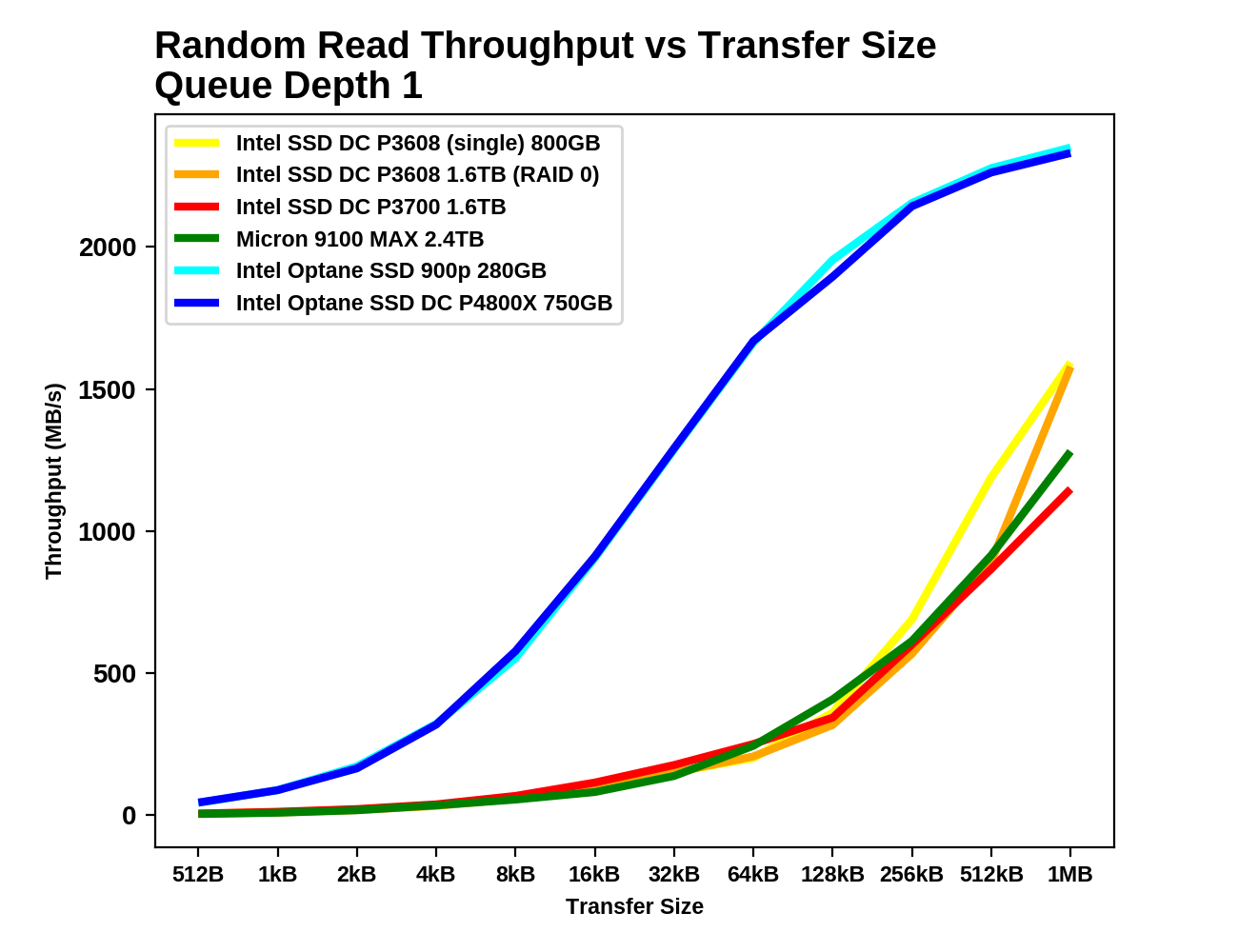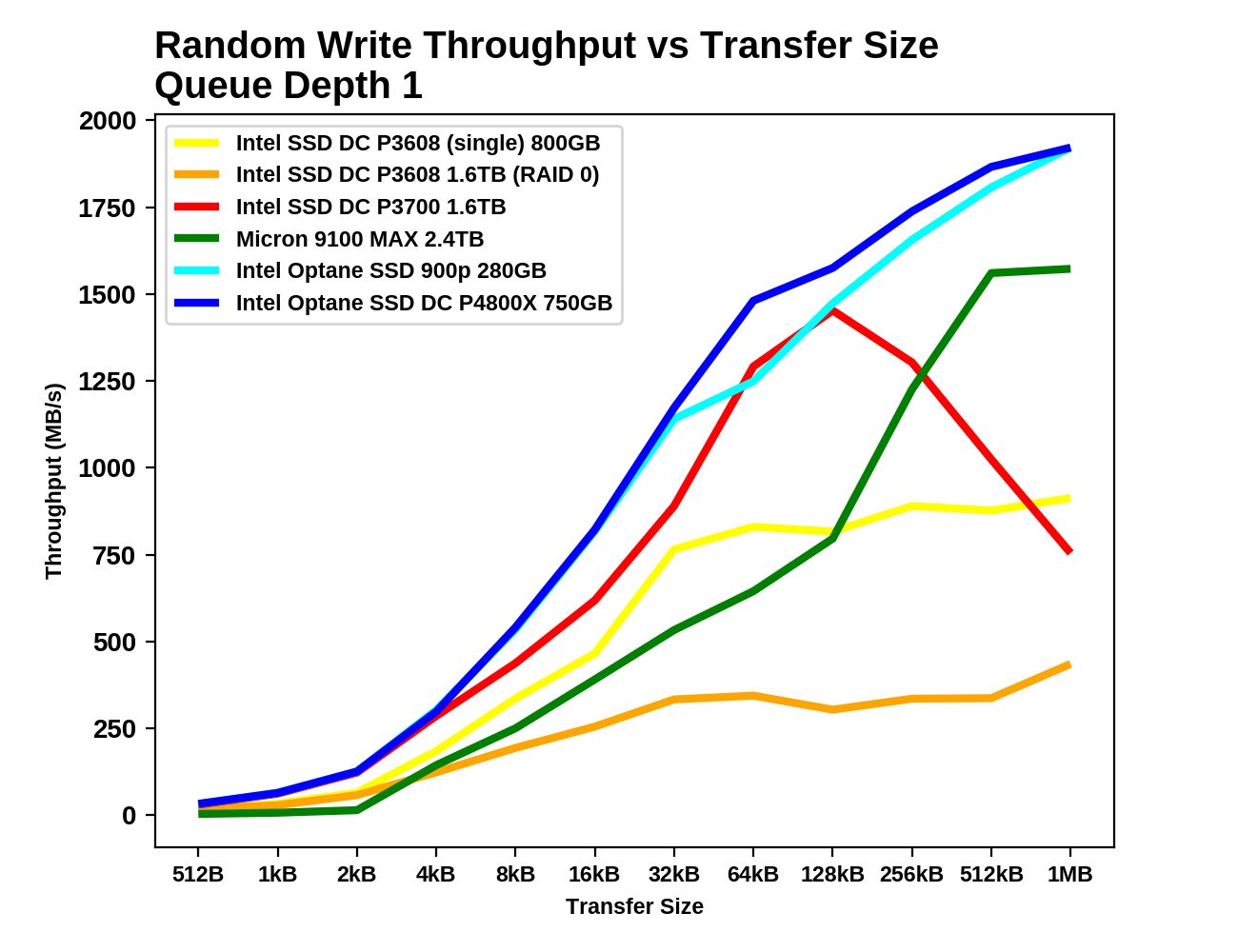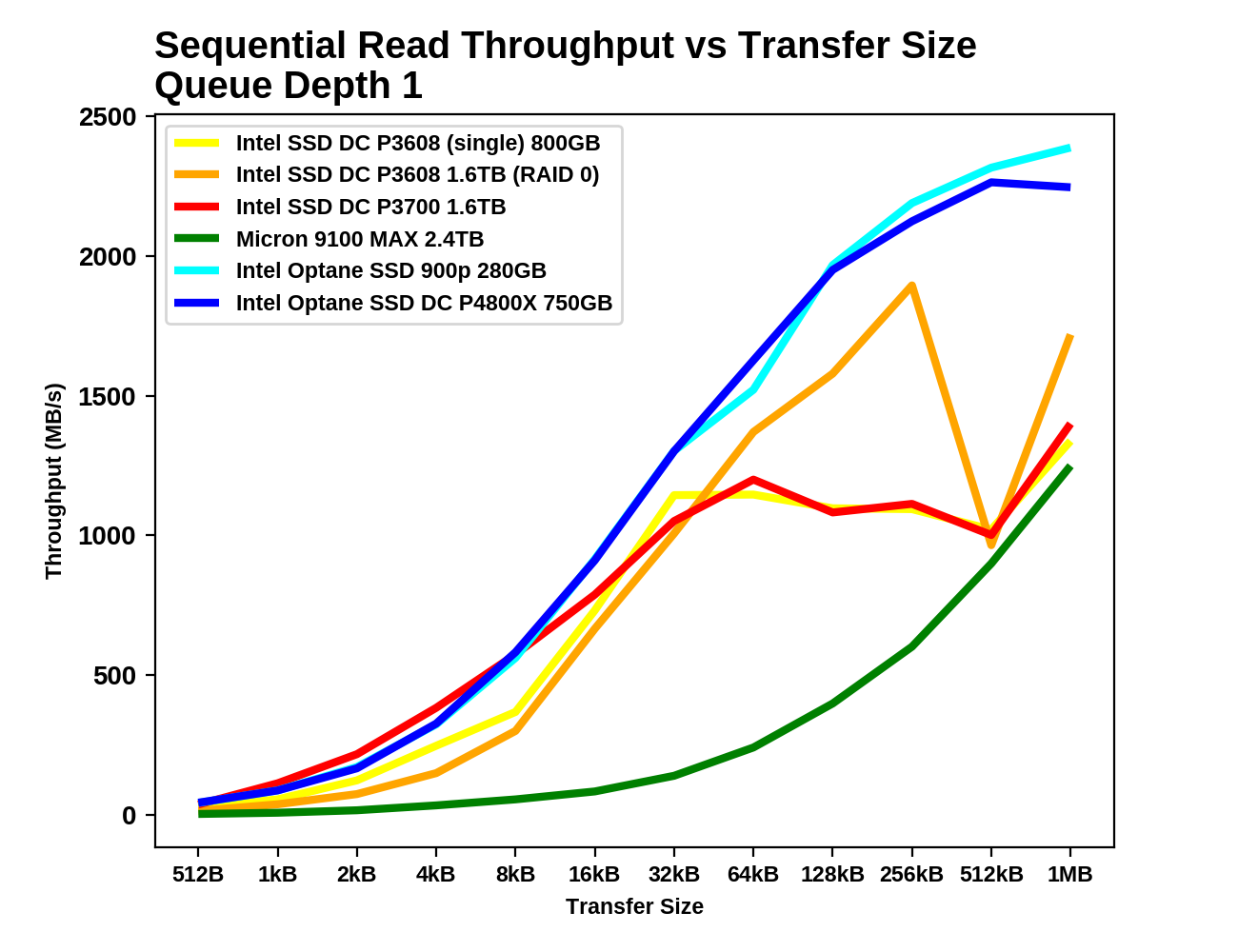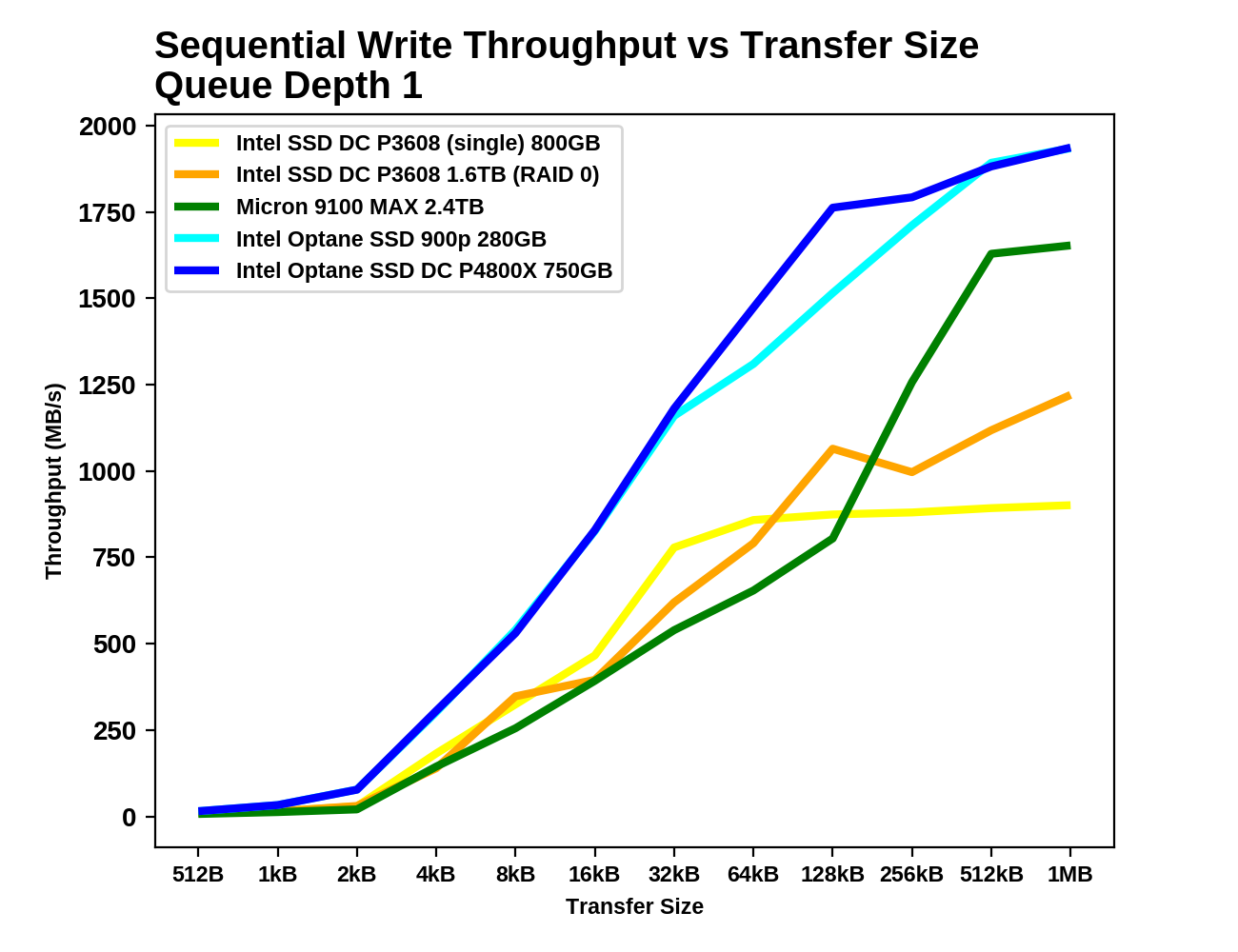Intel Optane SSD DC P4800X 750GB Hands-On Review
by Billy Tallis on November 9, 2017 12:00 PM ESTPerformance VS Transfer Size
Intel's 3D XPoint memory is not bound by the page and erase block structure of NAND flash. Intel hasn't disclosed what the native word size of the 3D XPoint memory array is, but the Optane SSD DC P4800X as a whole is optimized for 4kB or larger transfers. Real-world I/O isn't always constrained to just the 4kB and 128kB transfer sizes most of our synthetic benchmarks use, so the next several tests look at single-threaded QD1 performance of transfers ranging from a single 512-byte sector up to 1MB blocks. For random reads and writes, the impact of issuing commands with suboptimal alignment is also considered. Depending on how a drive is organized internally, unaligned accesses can significantly increase the amount of work the controller needs to do.
 |
|||||||||
| Vertical Axis scale: | |||||||||
| Block Aligned | Linear | Logarithmic | |||||||
| 512B Aligned | Linear | Logarithmic | |||||||
The random read performance of the Optane SSDs is completely beyond the reach of the flash based SSDs, even for large block sizes. Even when the reads aren't aligned to the block size or to the drive's preferred 4kB alignment, performance is still great until the block size reaches 128kB, the largest the Optane SSD can transfer from a single command. At that point, the Optane SSDs slow down slightly before performance continues to grow at a more moderate pace.
 |
|||||||||
| Vertical Axis scale: | |||||||||
| Block Aligned | Linear | Logarithmic | |||||||
| 512B Aligned | Linear | Logarithmic | |||||||
The random write performance of the Optane SSDs is not much better than the Intel P3700, especially for writes smaller than 4kB. The Intel P3608 and Micron 9100 MAX are slower across the entire range of block sizes. For unaligned writes of larger block sizes, the Optane SSDs hit a hard limit at around 1.3GB/s while properly aligned writes can approach 2GB/s for large blocks.
 |
|||||||||
| Vertical Axis scale: | Linear | Logarithmic | |||||||
The Intel P3700 delivers a slightly higher QD1 sequential read throughput for small block sizes, likely due to the controller caching whole NAND pages in RAM. At the larger block sizes more typically used for sequential I/O, the Optane SSDs are on top and the many of the flash-based SSDs cannot reach full performance without going beyond QD1.
 |
|||||||||
| Vertical Axis scale: | Linear | Logarithmic | |||||||
None of the SSDs perform particularly well for writes smaller than 4kB, but the Optane SSDs do have a clear advantage. As transfer size grows, the Optane SSDs pick up speed faster than the flash-based SSDs. The Intel P3608 is the first to start hitting a performance ceiling, while the Micron 9100 is almost able to catch up to the Optane SSDs.










58 Comments
View All Comments
Lord of the Bored - Thursday, November 9, 2017 - link
Me too. ddriver is most of why I read the comments.mkaibear - Friday, November 10, 2017 - link
He is always good for a giggle. I suppose he's busy directing hard drive manufacturers to make special hard drive platters for him solely out of hand-gathered sand from the Sahara. Or something.Still it's a shame to miss the laughs. It's always the second thing I do on SSD articles - first read the conclusion, then go and see what deedee has said. Ah well.
extide - Friday, November 10, 2017 - link
Please.. don't jinx us!rocky12345 - Thursday, November 9, 2017 - link
Interesting drive to say the least. Also a well written review thanks.PeachNCream - Thursday, November 9, 2017 - link
30 DWPD over the course of 5 years turns into a really large amount of data when you're talking about 750GB of capacity. Isn't the typical endurance rating more like 0.3 DPWD for enterprise solid state?So this thing about Optane on DIMMs is really interesting to me. Is the plan for it to replace RAM and storage all at once or to act as a cache or some sort between faster DRAM and conventional solid state? Even with the endurance its offering right now, it seems like it would need to be more durable still for it to replace RAM.
Oh (sorry case of shinies) could this be like a DIMM behind HBM on the CPU package where HBM does more of the write heavy stuff and then Optane lives between HBM and SSD or HDD storage? Has Intel let much out of the bag about this sorta thing?
Billy Tallis - Thursday, November 9, 2017 - link
Enterprise SSDs are usually sorted into two or three endurance tiers. Drives meant for mostly-read workloads typically have endurance ratings of 0.3 DWPD. High-endurance drives for write-intensive uses are usually 10, 25 or 30 DWPD, but the ratings of high-endurance drives have decayed somewhat in recent years as the market realized few applications really need that much endurance.lazarpandar - Thursday, November 9, 2017 - link
Can this be used to supplement addressable system memory? I remember Intel talking about that during the product launch.Billy Tallis - Thursday, November 9, 2017 - link
Yes. It makes for a great swap device, especially with a recent Linux kernel. Alternatively, Intel will sell it bundled with a hypervisor that presents the guest OS with a pool of memory equal in size to the system's DRAM plus about 85% of the Optane drive's capacity. The hypervisor manages memory placement, so from the guest OS's perspective the memory is a homogeneous pool, not x GB of DRAM and y GB of Optane.tuxRoller - Friday, November 10, 2017 - link
It's a bit odd Intel would go for the hypervisor solution since the kernel can handle tiered pmem and it's in a better position to know where to place data.I suppose it's useful because it's cross-platform?
xype - Friday, November 10, 2017 - link
I’d guess a hypervisor solution would also allow any critical fixes to be propagated faster/easier than having to go through a 3rd party (kernel) provider?